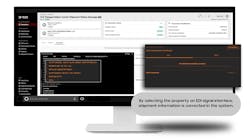SmartDrive Systems is releasing two new capabilities to its transportation technology system aimed at protecting truck drivers during unsafe situations on — and along—the road.
The video-based safety and transportation intelligence company is adding Speeding for Conditions and Sitting Duck to its SmartDrive SmartSense line of driver-assist sensors, the San Diego-based company announced on July 21.
In advance of the public release, some of the nation’s largest carriers, including Knight-Swift Transportation, tested the new offerings. The technologies are supposed to help truckers avoid driving too fast in bad weather and assist drivers who stopped at unsafe locations.
“This is all about how we empower the driver and provide them with the right information at the right time,” SmartDrive COO Jason Palmer told industry media during a virtual press conference in advance of the launch. “We continue to look at ways that we can leverage machine learning and artificial intelligence to leverage our sensors and information that's streaming off the vehicle — from the engine, the computer, the vehicle bus that's providing us intelligence, the sensors that we install on the vehicle — to allow the fleet and the operator to provide better decision-making criteria for them.”
Speeding for Conditions
While speeding can be a problem for some fleets, driving too fast for road or weather conditions is a problem for many — particularly when road conditions change unexpectedly. This is a factor in 23% of truck crashes, according to Federal Motor Carrier Safety Administration (FMCSA) data.
“With insurance premiums, nuclear verdicts and everyday driving risks skyrocketing, fleets must be able to identify hidden dangers and proactively address them,” noted SmartDrive CEO Steve Mitgang.
More than 70% of U.S. roads are in regions receiving more than five inches of snow annually. In those conditions, it can take trucks 10 times longer to stop on snow and ice than on dry pavement, according to SmartDrive data. This was a driver for developing the Speeding for Conditions solution to SmartSense, Mitgang said.
The technology measures vehicle speed against a recommended — or fleet customized — standard for safe driving during specific conditions. SmartSense provides real-time data to assess the severity of driving too fast for conditions — particularly in fog, rain or snow. It then alerts drivers of the risks within minutes and recommends a more appropriate speed for those conditions.
When it comes to speeding and stopping, the driver is the most important part of the equation, according to Brett Sant, senior vice president of safety and risk for Knight-Swift, who joined the SmartDrive press conference.
“We need to have competent, capable and conscientious drivers making these decisions and they have to be the ones who are making the decisions,” Sant said. “So these tools are intended to support and help the driver make better decisions and be better equipped to make the decisions in those conditions.”
He said the new technology empowers drivers to make those decisions without being second-guessed. “Because frankly, nobody knows the conditions that they’re dealing with contemporaneously better than the driver,” he added. “I think it's really important that we recognize the value and importance of the driver and how to leverage technology to help our drivers and to support them.”
Sitting Duck
Over the years, Knight-Swift has seen drivers injured when parked along the roadway in sitting-duck situations. Sant said his fleet’s trucks were hit by other vehicles driven by impaired drivers or motorists who fell asleep. “Our intention is to protect our drivers and — to the extent that we can — protect other motorists, recognizing that we don’t control the behavior of the other motorists. We can only affect the decision-making of our driver.”
That is a problem SmartSense for Sitting Duck attempts to solve.
The shortage of enough available truck parking along some of the country’s busiest highways can create dangerous and costly predicaments for drivers who end up parking in undesignated and unsafe locations. From mandated driver breaks to other unavoidable stops or maintenance issues, fleets face sitting-duck situations that put professional drivers and other motorists at risk.
The Sitting Duck addition to SmartSense detects and reports vehicles that stopped, parked or stalled in a potentially hazardous location. It provides real-time data so fleet managers can assess the incident to offer immediate, corrective action to the driver. It also delivers video insight into why and where the driver is stopped or parked. The software also allows fleet managers to zoom in on previously recorded satellite and street-level images to get a better view of what the area around the stopped vehicle is like.
“We can then quickly advise our driver on how to handle the situation and, if necessary, provide support — or send assistance — and get them back on the road safely,” Sant said.
Both new SmartSense features operate on the SmartDrive Transportation Intelligence Platform, which means intelligent data alerts are integrated with a fleet’s existing telematics messaging system. This enables drivers to get alerts before entering an area impacted by weather so they can slow down for conditions. It also alerts drivers parked longer than necessary to contact dispatch.
Manager notifications are triggered if corrective action is not taken. The real-time, interactive dashboards provide at-a-glance data so fleet managers can quickly identify trends and intervene before issues become widespread, according to Palmer.













